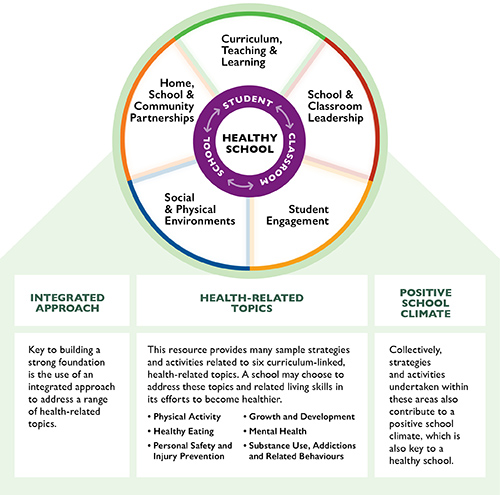The Foundations for a Healthy School resource from the Ontario Ministry of Education promotes and supports child and student well-being. It focuses on the whole child and student - their cognitive, emotional, social, and physical development.
This resource incorporates the five key areas adapted from the School Effectiveness Framework K-12.
A Healthy Schools approach looks beyond the classroom to the entire school setting.
This resource supports the integration of healthy school policies, programs, and initiatives into school and school board planning and implementation processes.
It involves students, staff, parents, volunteers and community partners.
Together, they share ideas, plan, and take action to help kids lead healthy, active lives.

Learn more about the five key areas below:
Curriculum, teaching and learning provide students with a wide range of opportunities to learn and practice positive behaviors, and demonstrate knowledge and skills related to living a healthy life.
Elementary and secondary school educators can find credible teaching resources organized by public health topic in the Resources for Educators, Parents/Caregivers, and Students section.
School and classroom leadership asks all members of the school community to work together to create a positive classroom and school environment. School and classroom leadership includes:
- Creating healthy schools policies and programs
- Encouraging collaborative learning and innovation
- Collecting and reviewing information to identify school community priorities
Students need to feel like they belong at their school, they need to feel informed, interested and encouraged to participate in and lead academic and non-academic activities. When students feel empowered and value their learning they become more engaged and have better learning outcomes. Student engagement includes:
- Providing opportunities for students to be involved in where, how, and what they learn.
- Helping students develop skills to be self-directed and self-monitored when it comes to how they want to learn.
- Creating safe spaces for student input related to school and community based polices, programs, and initiatives.
Social and physical environments are important for student learning. Social and physical environments that feel safe, caring, and healthy, can contribute to better learning and social, emotional, and physical development. The social and physical environments includes:
- Continuous support and development of positive relationships with the school and school community
- Understanding how the school environment is affected by the school surrounding and neighbourhoods
Home, school, and community partnerships engage parents/caregivers, families, school staff, and community organizations and programs by providing resources, programs, and services, to support and promote student health and well-being.
To find out more about the Foundations for a Healthy School contact your school’s Public Health Nurse or the Healthy School’s Department at (519) 258-2146, ext. 1555.

